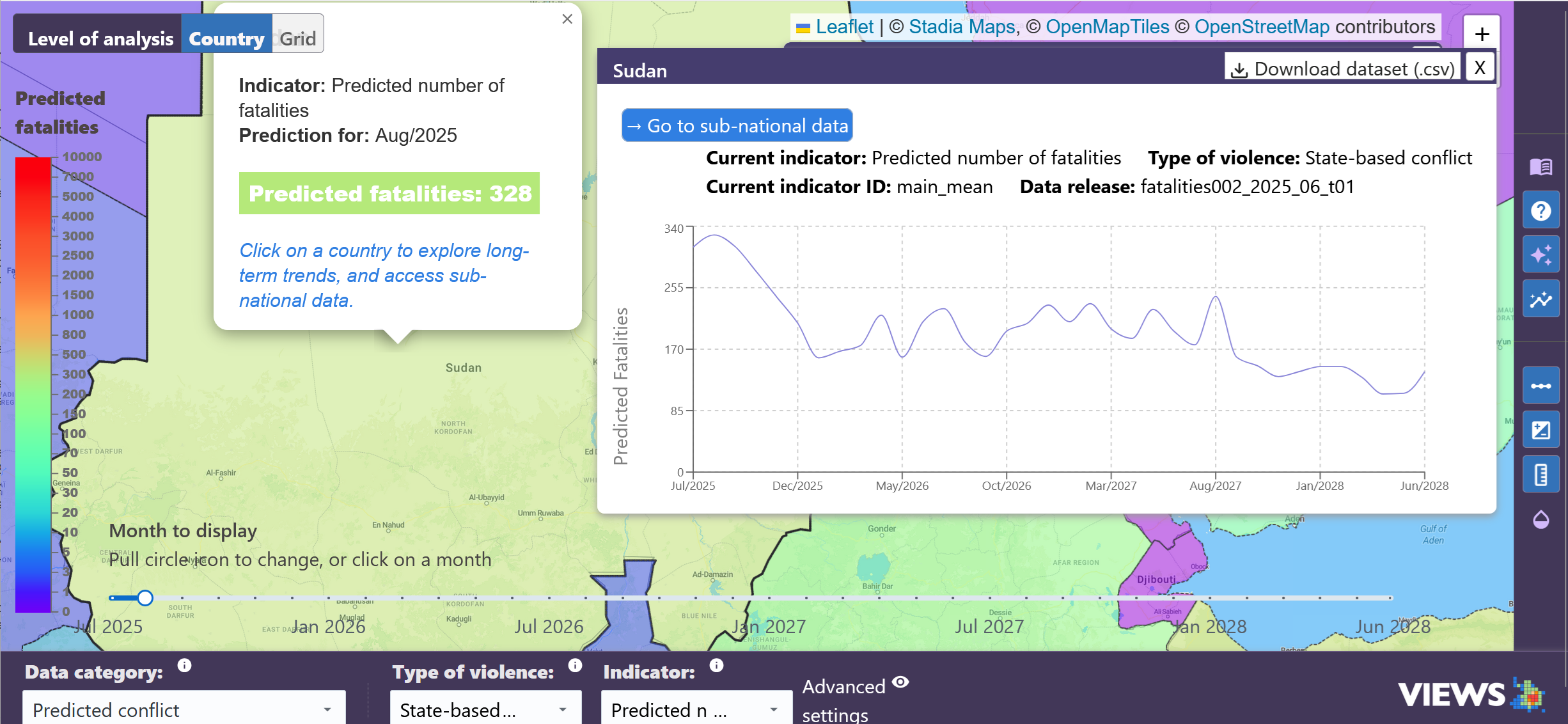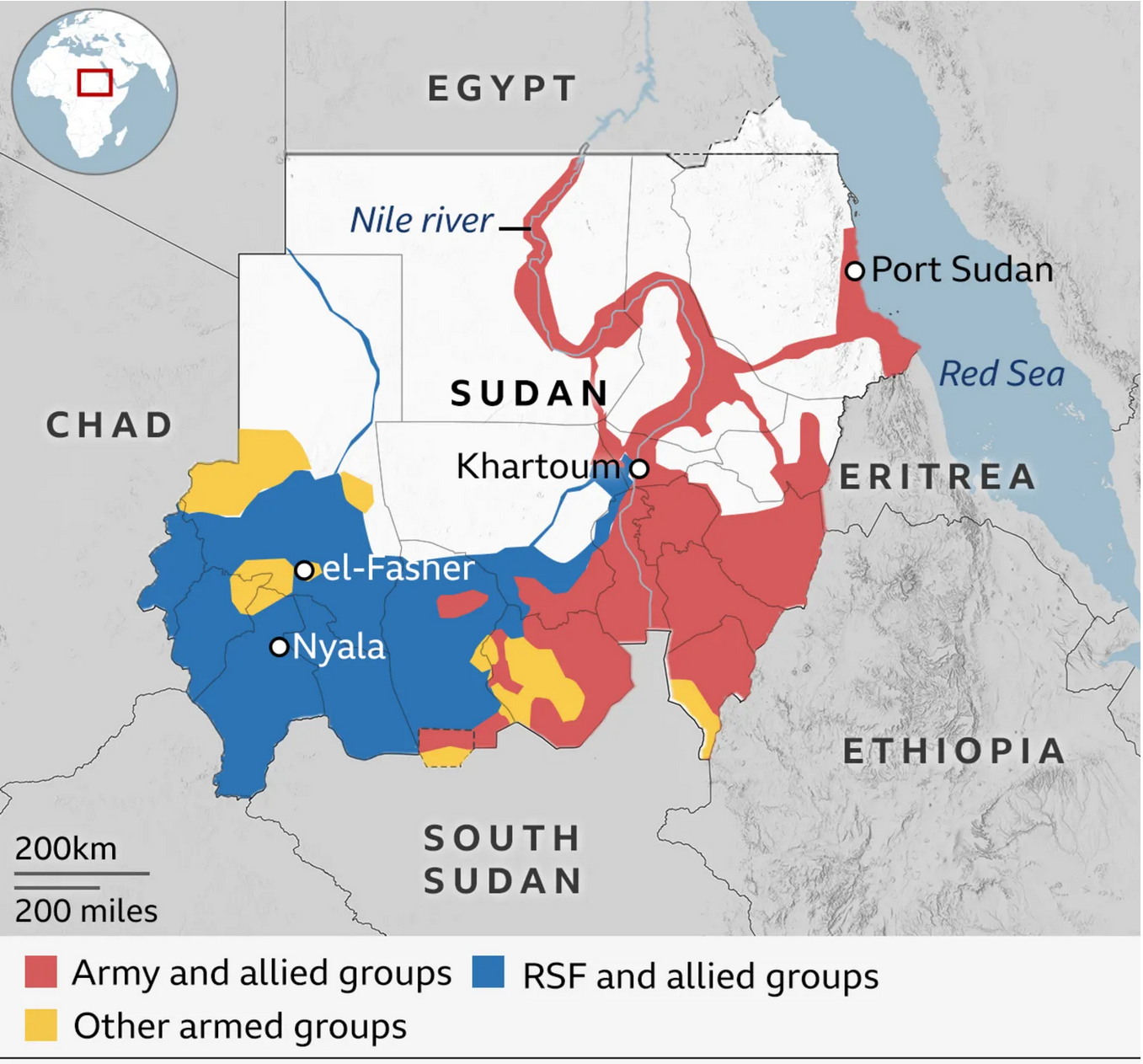How many state-based conflict deaths in Sudan will be reported by ACLED for 2025?
Here’s what Jeremy Lichtman’s Multi-AI Oracle predicts today:
* Less than 1000: 1%
* Between 1,000 and 3,000: 5%
* Between 3,000 and 5,000: 11%
* Between 5,000 and 8,000: 25%
* Between 8,000 and 12,000: 37%
* More than 12,000: 21%
12–15 minutes read
Obtaining outside data.
Checking internet sources, using keywords: ACLED Sudan 2025 conflict deaths
News from various sources:
The content from the web article is primarily focused on the humanitarian crisis in Sudan as of 2025, particularly the impact of the ongoing conflict on public health and civilian life. The conflict involves a power struggle between the Sudanese Armed Forces (SAF) and the Rapid Support Forces (RSF), which began in April 2023 and has resulted in more than 150,000 deaths.
Key points include:
– **Human Impact**: The conflict has resulted in the displacement of 12 million people, with a significant number of children affected. Issues such as malnutrition, family separation, and trauma are prevalent among displaced children. There is a rise in gender-based violence, with systematic use of rape as a weapon of war, affecting very young girls and leading to stigmatization and lack of mental health support.
– **Health System Collapse**: The conflict has severely impacted the health system, with less than 30% of health facilities remaining functional. Attacks on hospitals, health workers, and medical supplies are common, with over 1000 people killed in 38 such attacks in the first half of 2025.
– **Public Health Emergency**: The destruction of the health system has resulted in outbreaks of diseases such as cholera, measles, and malaria. The cholera outbreak alone has resulted in over 83,000 cases and 2100 deaths. Additionally, hunger and food insecurity are worsening, with 20 million people facing acute food shortages.
– **International Response**: The global response has been inadequate, with only 23% of the UN’s $4.16 billion Humanitarian Needs and Response Plan for Sudan funded. Political challenges and lack of international media attention contribute to the continued neglect of the crisis.
– **Political Situation**: Efforts for a peaceful resolution are hampered by ongoing rivalries and the establishment of a rival government by the RSF, challenging the SAF-led authorities.
In summary, the article highlights the severe humanitarian consequences of the ongoing conflict in Sudan, the collapse of the health system, the inadequate global response, and the political challenges impeding resolution efforts.
Fact-checking news summary:
To analyze the summary and ascertain the accuracy and relevance of each fact, we’ll break down the key points and assess them systematically:
1. **Fact**: The conflict involves a power struggle between the Sudanese Armed Forces (SAF) and the Rapid Support Forces (RSF), which began in April 2023 and has resulted in more than 150,000 deaths.
– **Correctness**: Needs external validation, but internally consistent. As of the latest data (up to 2023), the conflict between SAF and RSF did indeed begin in April 2023.
– **Importance**: Critical, as it is central to understanding the background of the humanitarian crisis and the question regarding conflict deaths.
– **Relevance**: True, directly related to estimating conflict deaths reported by ACLED in 2025.
2. **Fact**: The conflict has resulted in the displacement of 12 million people, with a significant number of children affected.
– **Correctness**: Needs external validation. Internally, this displacement level signals a severe humanitarian impact but is extremely high and should be checked against reliable sources for verification.
– **Importance**: Important, as it reflects the scale of the crisis.
– **Relevance**: True, as displacement relates to the severity and impact of the conflict.
3. **Fact**: The health system is severely impacted, with less than 30% of health facilities functional.
– **Correctness**: Needs external validation. Such details should be corroborated with reliable health and humanitarian reports to ensure accuracy.
– **Importance**: Important, as it provides context to the humanitarian situation and its effects on conflict-related death reporting.
– **Relevance**: True, relevant in understanding the broader implications of the conflict.
4. **Fact**: Over 1,000 people killed in 38 attacks on hospitals in the first half of 2025.
– **Correctness**: Needs external validation; internally, this suggests targeted violence but seems high for such attacks.
– **Importance**: Important, as it reflects on the severity of targeting health infrastructure.
– **Relevance**: True, as it ties to conflict mortality and humanitarian challenges.
5. **Fact**: Cholera outbreak resulted in over 83,000 cases and 2,100 deaths.
– **Correctness**: Needs external validation; reliable health data sources needed for confirmation.
– **Importance**: Important, as public health crises can escalate conflict-related mortality indirectly.
– **Relevance**: True, contextualizes indirect conflict-related deaths influencing reported figures.
6. **Fact**: Hunger and food insecurity, with 20 million people facing acute food shortages.
– **Correctness**: Needs external validation; data check required but aligns with severe crisis scenarios.
– **Importance**: Important, as it impacts overall mortality but more indirectly related to conflict deaths.
– **Relevance**: True, indirectly pertains to impact severity.
7. **Fact**: Only 23% of the UN’s $4.16 billion Humanitarian Needs and Response Plan for Sudan funded.
– **Correctness**: Needs external validation, should match detailed financial contributions data.
– **Importance**: Important, highlights inadequate response, affecting crisis management.
– **Relevance**: False, indirectly related as it influences effort to mitigate conflict effects but not directly on reported death tally.
8. **Fact**: Political resolution efforts hampered by ongoing rivalries and establishment of a rival government by the RSF.
– **Correctness**: Internally consistent and plausible, considering known 2023 rivalries, but should be validated externally.
– **Importance**: Important, it affects the continuation and intensity of the conflict.
– **Relevance**: False, political developments are indirectly linked to actual death counts reported.
Overall, while most facts need external validation for confirmation, they provide significant context or background against which the ACLED data might be understood in 2025. However, particular emphasis should be put on those facts tightly connected to conflict mortality, such as the number of deaths and nature of violence, when assessing specific future mortality reporting by ACLED.
Fact-checked summary:
The ongoing conflict in Sudan, which began in April 2023 between the Sudanese Armed Forces (SAF) and the Rapid Support Forces (RSF), has resulted in a significant humanitarian crisis. This power struggle is central to understanding the current and potentially future state-based conflict deaths. Displacement is another critical issue, with 12 million people affected, indicating the scale and severity of the crisis. Additionally, only less than 30% of health facilities are currently functional, underlining the impact of the conflict on the healthcare system, which is relevant to assessing conflict-related deaths. A cholera outbreak with over 83,000 cases and 2,100 deaths further exacerbates the situation, influencing indirect conflict-related mortality. These elements are important for contextualizing the state of Sudan and understanding potential future mortality reports by organizations such as ACLED.
OpenAI gives a base rate of probability of conflict deaths being more than 8000
The question difficulty is rated 7 (0 to 10)
Historical weighted factors include:
0.4, increasing
0.3, decreasing
0.2, increasing
0.1, minimal
A Bayesian calculation could be performed as follows:
P(More_than_8000|Evidence) = [P(Evidence|More_than_8000) * P(More_than_8000)] / P(Evidence). Using current conflict intensity and health infrastructure deterioration, with minimal international intervention, adjust probabilities upwards. Assume P(Evidence|More_than_8000) > P(Evidence|Less_than_8000), leading to a posterior around 0.8.
Bayesian base rate: 0.8 (Carolyn’s note: sometimes this answer is an actual forecast, but in the case of multiple bins, we don’t know what the Multi-Oracle means by this.)
Sufficient news to provide a good forecast? 1 (0 or 1)
News is relevant, topical and unbiased? 1 (0 or 1)
Question classification: scenario_based_forecast
Expected time (days) until question close: 180
The following were considered in order to produce this base rate:
The ongoing severe conflict between SAF and RSF, combined with a deteriorating healthcare system and a significant cholera outbreak, are key contributors to a high base rate of mortality. Historical data on similar conflicts and their mortality rates suggest a consistently high fatality count under such conditions.
Ideally, the news feed would contain the following sorts of information for a better forecast:
Access to up-to-date conflict death reporting data and precise healthcare infrastructure reports would enhance forecasting accuracy. Information on potential upcoming international interventions or local peace initiatives would also be valuable.
Some potential divergent considerations that might affect the base rate:
Factors that could reduce the death toll include unexpected international diplomatic intervention or an effective peace agreement, which are considered unlikely though possible scenarios. Additionally, if significant aid were to improve medical services, it could decrease fatalities related to health infrastructure collapse and disease.
The following chain of events are necessary for the question to resolve positively:
Continued conflict between SAF and RSF Highly Likely – Lack of resolution or peace talks Likely – Continued strain and deterioration of health services Highly Likely – Continued spread and impact of cholera Moderately Likely
Querying Claude (AI predicts: [“Less than 1000”: 0.01, “Between 1000 and 3000”: 0.05, “Between 3000 and 5000”: 0.15, “Between 5000 and 8000”: 0.25, “Between 8000 and 12000”: 0.35, “More than 12000”: 0.19] – confidence: 6)
Querying Mistral (AI predicts: [“Less than 1000”: 0.01, “Between 1000 and 3000”: 0.05, “Between 3000 and 5000”: 0.1,
“Between 5000 and 8000”: 0.24, “Between 8000 and 12000”: 0.4, “More than 12000”: 0.2] – confidence: 6)
Querying OpenAI (AI predicts: [“Less than 1000”: 0.01, “Between 1000 and 3000”: 0.05, “Between 3000 and 5000”: 0.1, “Between 5000 and 8000”: 0.18, “Between 8000 and 12000”: 0.3, “More than 12000”: 0.36] – confidence: 7)
Question Type: Multiple Choice
Confidence: 6
MAPD: Avg: 0.043333333333333, Max: 0.11333333333333
# LLM responses: 3
Explanations of the above statistical measures here —>
Model value:
* Less than 1000: 1%
* Between 1,000 and 3,000: 5%
* Between 3,000 and 5,000: 11%
* Between 5,000 and 8,000: 25%
* Between 8,000 and 12,000: 37%
* More than 12,000: 21%
The various AI models predict high mortality rates in Sudan due to the ongoing conflict between the Sudanese Armed Forces (SAF) and the Rapid Support Forces (RSF) that began in April 2023. This conflict has created a severe humanitarian crisis, displacing 12 million people and leaving less than 30% of health facilities functional amidst a cholera outbreak that has resulted in over 83,000 cases and 2,100 deaths. These factors, alongside historical patterns of mortality in similar conflicts, contribute to a high death toll, which is exacerbated by the collapse of healthcare infrastructure and ongoing violence. While international diplomatic intervention or effective peace agreements could potentially reduce the death toll, these are considered unlikely. The predictions recognize some uncertainty related to ACLED’s methodology for categorizing conflict-related deaths and the potential for reporting delays, as well as the impact of potential peace agreements or effective aid that could mitigate the crisis.
Runtime: 127 seconds.
`Past forecasts by Phil’s and Jeremy ’s bots —>
Below, a forecast of state-based conflict fatalities for Sudan in the VIEWS machine forecasting competition, (image below) which is an aggregate of the forecasts of twenty machine learning competitors. Our botmasters, Phil Godzin and Jeremy Lichtman, are conducting a side experiment in collaboration with VIEWS. The VIEWS aggregate forecast is much lower than ours.


Source: Thomas van Linge, Institute of War, 1 May 2025, as reported by the BBC, https://www.bbc.com/news/articles/cjel2nn22z9o

